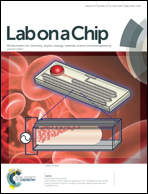Integrated fluorescence detection of labeled biomolecules using a prism-like PDMS microfluidic chip and lateral light excitation
Abstract
Microfabricated amorphous silicon photodiodes were integrated with prism-like PDMS microfluidics for the detection and quantification of fluorescence signals. The PDMS device was fabricated with optical quality surfaces and beveled sides. A 405 nm laser beam perpendicular to the lateral sides of the microfluidic device excites the fluorophores in the microchannel at an angle of 70° to the normal to the microchannel/photodiode surface. This configuration, which makes use of the total internal reflection of the excitation beam and the isotropy of the fluorescence emission, minimizes the intensity of excitation light that reaches the integrated photodetector. A difference of two orders of magnitude was achieved in the reduction of the detection noise level as compared with a normally incident excitation configuration. A limit-of-detection of 5.6 × 1010 antibodies per square centimeter was achieved using antibodies labeled with a model organic fluorophore. Furthermore, the results using the lateral excitation scheme are in good proportionality agreement with those by fluorescence quantification using wide-field fluorescence microscopy.


 Please wait while we load your content...
Please wait while we load your content...